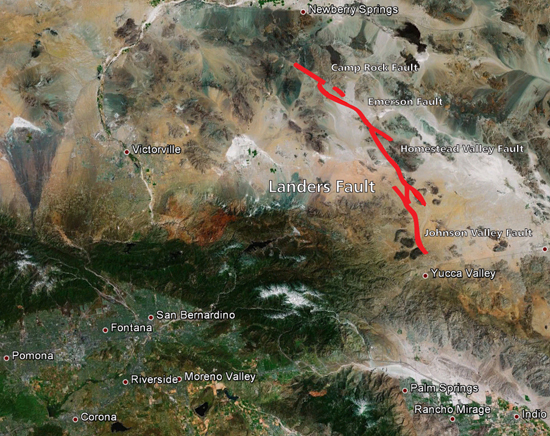
The Landers Earthquake: Still Teaching Us About Stress Transfer 20 Years Later
Jun 14, 2012
Editor's Note: This month marks the 20th anniversary of the June 28, 1992, Landers earthquake, which is more notable for what it taught seismologists about fault interaction and stress transfer than for the insured losses or damage it incurred. Dr. Mehrdad Mahdyiar, AIR Director of Earthquake Hazard, discusses why the event was important and shares the lessons Landers is still providing today.
On June 28, 1992, at 4:57AM local time, a magnitude 7.3 (M7.3) earthquake struck Southern California's Mojave Desert, six miles north of Yucca Valley and 120 miles from Los Angeles. Named for the small town nearest the epicenter, the Landers earthquake was the largest to hit the contiguous United States in 40 years; but, because it struck a relatively sparsely populated area, it caused little damage. If the Landers quake were to strike today, insured losses would total only USD 180 million. By comparison, if the 1906 San Francisco earthquake, a M7.8 quake, were to recur today, it would cost the insurance industry more than USD 90 billion.
By means of a cascading rupture—whereby the rupture of one fault triggers the rupture of a neighboring fault— the Landers main shock ruptured five separate fault segments in sequence: Johnson Valley, Landers, Homestead Valley, Emerson, and Camp Rock, as shown in Figure 1. The Landers quake is therefore also sometimes referred to as "the Landers sequence." The total length of the rupture was approximately 80 kilometers, or nearly 50 miles. It is thought that the complex network of five right-lateral strike-slip faults had not experienced a major rupture in thousands of years, although the Homestead Valley segment had experienced a surface rupture singly 13 years prior.

The Landers quake surprised many seismologists, as it revealed a jigsaw of interconnectivity underground that had not been previously apparent. The multi-segment rupture of Landers clearly demonstrated the possibilities for complex rupture scenarios and mechanisms for creating large magnitude earthquakes.
The Landers rupture and the subsequent quakes it triggered spawned many questions about stress transfer, such as: How far from the main shock could stress be transferred? By how much could an earthquake increase the seismicity of the surrounding region, and for how long? Under what conditions does one earthquake trigger another? Could this earthquake have been anticipated? While these questions are still under active investigation 20 years later, the concept of stress transfer made salient by Landers is now widely used to quantify and capture the impact of large magnitude earthquakes on regional and local earthquake hazard around the world.
Aftershocks and Triggered Events: A Closer Look
On its own, the Landers sequence would in any event be of great interest to seismologists, but the aftershocks and small magnitude remote earthquakes it triggered were without precedent, offering many clues as to the ways in which the earth's crust could fail.
Three hours after Landers, the M6.4 Big Bear earthquake struck 40 km, or about 25 miles, west of the Landers rupture. Described initially as a separate earthquake, it was categorized by some seismologists as an aftershock and by others as a triggered event. Among the considerations were, first, it was within one rupture-length of the Landers main shock and, second, its magnitude was consistent with that of an aftershock of a quake the size of Landers. In addition, it was shown that the Landers earthquake had increased the state of stress on the Big Bear fault, triggering its rupture.
The Big Bear fault could be considered conjugate to the five faults that slipped during Landers, meaning that Big Bear's left-lateral strike-slip intersected—or nearly intersected—with the right-lateral strike-slip faults involved in Landers. Conjugate faults sometimes slip within hours or days of each other, causing pairs of earthquakes.
Soon after the Landers earthquake, there was an increase in microseismic activity, or faint tremors, within the western part of the U.S. at a number of locations—even as far away as Yellowstone National Park. The distant microseismic activity resulting from the rupture was unprecedented at the time and launched a series of seismological studies to understand the mechanisms of remote triggering due to dynamic stresses and the passage of long period seismic waves.
During the years following Landers, seismicity within the aftershock vicinity gradually decreased from its immediately heightened state, as would be predicted by the Omori law decay, an empirical relationship describing the decay in the rate of aftershocks over time. Then, a full seven years after Landers and 30 km, or 18 miles, to the northeast, the M7.1 Hector Mine quake struck on October 16, 1999, when seismicity in the region was decreasing but still higher than before the Landers earthquake. Deemed a separate event initially, as was Big Bear, the Hector Mine quake is now considered a triggered event. The seven-year delay is attributed to a complex viscoelastic stress buildup on the Hector Mine fault due to the relaxation of the earth's lower crust and upper mantle in response to the Landers earthquake.
Landers Fault Interaction Provides Opportunity to Study Stress Transfer
The Landers quake coincided with a time of major technological advances in seismic instrumentation and analysis. The growth in the number of Global Positioning System (GPS) stations throughout southern California was contributing to the understanding of strain accumulation and release. The high quality of data available from various data sources provided a first-time opportunity to model an earthquake such as Landers and study stress transfer in detail.
Before the Landers quake, seismologists were aware that the rupture of a major fault changes the state of stress on other regional faults. Post-Landers, seismologists gathered evidence of stress change through the results of stress analysis for a few large foreshocks that showed those foreshocks increased the state of stress on the Landers rupture area and thus increased rupture probability. As a result of Landers, seismologists all over the world began using physical models to calculate Coulomb failure stress on faults as a way of quantifying the increase or decrease in a fault's probability of rupturing.
Because the average return period of large earthquakes in the Landers region is on the order of thousands of years, the spatial and temporal proximity of the Landers/Big Bear/Hector Mine events were unlikely to be a coincidence. Seismologists have since used Coulomb stress changes to explain the fault interaction behind this sequence of triggered events.
Closing Thoughts: Modeling From Landers to Tohoku
Since the Landers earthquake, it has become a routine practice in most regional hazard studies—and in the development of AIR earthquake models—to consider multi-segment fault rupture scenarios to allow for the possibility of large magnitude earthquakes. The recent USGS and AIR national seismic hazard models consider very comprehensive multi-segment rupture scenarios for all major faults in California. Even so, when the M9.0 Tohoku earthquake ruptured four contiguous segments—the largest event by far in Japan's historical record—it took the scientific community by surprise. Indeed, Japan's Headquarters for Earthquake Research Promotion (HERP) did not consider it possible for such an event to occur in that segment of the Japan Trench, as an earthquake of such magnitude was not historically observed or recorded in that region.
Tohoku caused approximately 20,000 deaths and between USD 20 billion and USD 30 billion in insured losses—fatalities and monetary losses so far surpassing Landers' that it seems impossible to relate the two events. However, it is through the lens of Landers and the lessons Landers offered about stress transfer that seismologists are attempting to understand and evaluate Tohoku's potential impacts on seismicity in Japan. Seismologists are trying to answer the same questions asked 20 years earlier about Landers, in this case: What effect did the Tohoku earthquake have on the rupture probabilities of the numerous other faults in the region?
The Landers quake is little remembered or talked about today—except among seismologists, for whom it remains a significant event. Our understanding of seismicity continues to evolve and Landers still has many things to teach about stress transfer, offering much to contemplate when evaluating complex networks of faults around the world.

